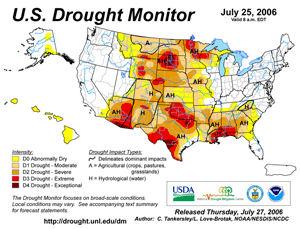July was second-hottest month in U.S. history
July was second-hottest month in U.S. history
mongabay.com
August 7, 2006
July was second-hottest month in U.S. history according to the National Climatic Data Center (NCDC). The average temperature for the 48 contiguous states was 77.2°F and more than 2,300 daily temperature records were broken across the country.
July was the warmest month since July 1936 when temperatures reached an average of 77.5°F. The most severely affected areas included southern Arizona, southern Texas and central South Dakota.

|
The average temperature for the continental United States from January through June 2006 was the warmest first half of any year since records began in 1895. NCDC data showed that the average January-June temperature for the contiguous United States was 51.8°F (11.0°C) — 3.4°F (1.8°C) above the 20th century (1901-2000) average. The government agency noted that five states (Texas, Oklahoma, Kansas, Nebraska, and Missouri) experienced record warmth for the period while no state was cooler than average.
NOAA also reported that last month was the second warmest June on record and national precipitation was below average. It said that continued below-normal-levels of precipitation combined with warmer-than-average temperatures expanded drought conditions across the country.
NOAA’s results come just months after a NASA study found that 2005 was the warmest year on record. Scientists say that rising concentrations of carbon dioxide in the atmosphere are contributing to climbing global temperatures. Recent research suggests that atmospheric carbon dioxide levels are at the highest level in at least 650,000 years. The Intergovernmental Panel on Climate Change (IPCC) projects that atmospheric carbon dioxide levels could rise significantly by 2050, possibly resulting in higher temperatures, rising sea levels, stronger storms and hurricanes, and expanding deserts.







